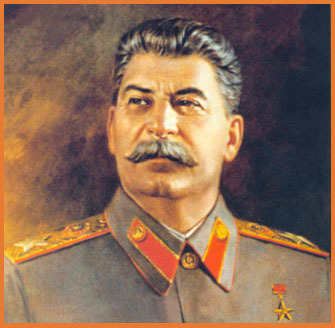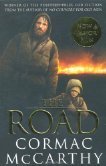Stephen Hayes's Blog, page 87
January 11, 2011
Theophany: the manifestation of God
The twelfth day after Christmas is the eve of the feast of Theophany, or Epiphany, the manifestation of Jesus as the Christ, or Messiah, and the manifestation of the Holy Trinity.
As one of the hymns of the feast puts it:
When Thou, O Lord, wast baptised in the Jordan
the worship of the Trinity was made manifest!
For the voice of the Father bare witness to Thee
and called Thee his beloved Son!
And the Spirit, in the form of a dove
confirmed the truthfulness of his Word.
O Christ our God who hast revealed thyself and enlightened the world
glory to Thee!
A question that some people sometimes ask is why our Lord Jesus Christ needed to be baptised. If we are baptised for the remission of our sins, and He was sinless, was his baptism not pointless? He was baptised by St John the Forerunner, who baptised with a baptism for repentance, but if Christ was without sin, why would he need to repent?
One could answer this very briefly by pointing out that our baptism and Christ's baptism are opposite in their meaning and significance. When we are baptised, one of the things that happens is that we ourselves are made clean of sin. We go into the water dirty, and come out clean. With Christ, it is the other way round. He goes into the water clean, and comes out bearing the sins of the world. We enter the water to be purified. When Christ enters the water, it is the water that is purified.
It is this purification of the water that we celebrate at the Great Blessing of the Waters at Theophany.
In the Scriptures water, especially in large quantities, is a symbol of evil. In creation the Spirit of God moves on the face of the waters, and brings order out of chaos. In the story of Noah, human sinfulness brings a great flood, which threatens to destroy all life. In the Exodus, the people of Israel escape from oppression and slavery in Egypt, but find the way to freedom is barred by the sea. After 40 years of wandering in the desert, they eventually cross the Jordan to enter the promised land.
Jonah is swallowed by a monster from the water, and St John in his Apocalypse, describes a sea between him and God (Rev 4:6). In chapter 12 the dragon tries to sweep away the woman who represents the church with a flood, and in chapter 13 a monster arises from the sea. Yet when the dragon is finally defeated, there is a new heaven and a new earth, and the sea no longer exists as a barrier between people and God (Rev 21:1). Instead there is a river, flowing from the throne of God, watering trees for the healing of the nations (Rev 22:1-2).
The Epistle reading (I Cor 10:1-4) describes how the people of Israel left Egypt, and were baptised into Moses in the cloud and in the sea, and this speaks to us of our baptism. The people of Israel pass from slavery in Egypt to the wilderness beyond, and eventually come to the promised land, the land of freedom. We pass from the slavery of Satan to the kingdom of God, from death to eternal life. Incidentally, this also illustrates why the Church baptises infants. We may be sure that the people of Israel carried their infants across the sea with them. They did not leave them on the Egyptian shore for Pharoah's army to find "because they were too young to understand it". Salvation and redemption are gracious acts of God, of which we are the beneficiaries, not mental exercises requiring our reasoning powers.
The sea is not merely a body of water. It is infested by evil and threatening monsters, which symbolise the power of Egypt, so Isaiah cries out:
Awake, awake, put on strength, O arm of the Lord
awake, as in days of old, the generations of long ago.
Was it not thou that didst cut Rahab in pieces
that didst pierce the dragon?
Was it not thou that didst dry up the waters of the great deep
that didst make the depths of the sea a way for the redeemed to pass over?
And the ransomed of the Lord shall return
and come to Zion with singing
everlasting joy shall be upon their heads
they shall obtain joy and gladness
and sorrow and sighing shall flee away (Is 51:9-11).
And, recalling this, when the priest blesses the water for baptism he says, "Thou didst hallow the streams of Jordan, sending down upon them from heaven thy Holy Spirit, and didst crush the heads of the dragons who lurked there."
When Christ was born in Bethlehem, God hid himself. As someone once pointed out, if you want to hide a needle, the best place to hide it is not in a haystack, because if you look long enough you can find it. If you want to hide a needle, you hide it among other needles. God became man, and hid himself among the human race, one baby among many who were born in that year. The shepherds, the wise men, the Theotokos and St Joseph, they knew because the angels and the star had revealed it to them. The rest did not know, until our Lord Jesus Christ stepped into the water of the Jordan to be baptised by St John. Then the word of the Father bore witness, and the truth of that word was confirmed by the Spirit. And Christ began his redeeming work by trampling on the heads of the dragons that lurked there; the prayer of Isaiah was fulfilled as the arm of the Lord awoke: the arm of the Lord that had hacked Rahab in pieces and pierced the dragon through.
The river Jordan, where it flows through the valley to the Dead Sea, is the lowest place on the surface of the earth. And Christ descended to the lowest place to purify the water of monsters and of evil, and at the same time to take our sins upon him. He went into the water to make it holy so that when we go into the water we can become holy as he is. When he went into the water he was reclaiming the earth from the evil one, and asserting his right as creator. He was reclaiming water, and by extension all of the material world, or nature, and redeeming it from the power of the evil one.
After his baptism, Christ, like the people of Israel, goes into the desert, and there he encounters the devil, who, having been expelled from the water, takes him to a high mountain, yet still claims the earth and its kingdoms as in his gift. Possession may be nine-tenths of the law, but it is not ten tenths, and possession does not make the devil the true owner.
The Theophany then is the manifestation of Christ for who he really is, the saviour of the world. It is the manifestation of the Trinity, one and undivided. And its the beginning of his saving work on earth as he confronts the powers of evil in the water, and reclaims water and the world for God.
____
This post is part of a synchroblog o the theme of The manifestation of God. A synchroblog is where a number of bloggers post on the same general theme on the same day. You can see some of the other posts on this theme in the links below:
Mike Victorino – What To Do?
Beth Patterson – A Robust Universe Includes The Botched and Bungled
Jeremy Myers – Pagan Prophecies Of Christ
Mark Smith – Manifestation Of God
Minnow – When God Shows Up
Alan Knox – A Day I Saw Jesus
Ellen Haroutunian – Stories of Epiphany
Liz Dyer – God Breaking Through Moments








January 10, 2011
Biography of Peter Brown, South African liberal leader
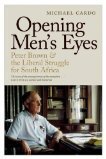 Opening Men's Eyes: Peter Brown and the Liberal Struggle for South Africa by Michael Cardo
Opening Men's Eyes: Peter Brown and the Liberal Struggle for South Africa by Michael Cardo
My rating: 4 of 5 stars
I generally enjoy reading biographies, but Michael Cardo's biography of Peter Brown is the the first one I have read that is about someone I knew fairly well, so I read it with more than usual interest, and perhaps more critically than usual. I read it to discover more about someone I had known, but also to discover whether the person described in the biography was the same as the person that I knew. And on the whole, I have to say yes — the character of Peter Brown that Michael Cardo captures is indeed the Peter Brown that I knew.
Peter Brown was one of the founders and leaders of the Liberal Party of South Africa, which, in the 1950s and 1960s, stood for the principle of a non-racial democracy in South Africa, and Peter Brown was one of its most principled and consistent exponents.
His background made it seem unlikely that he would be such a thing. He came from a fairly wealthy and privileged white farming and merchant family, and white farmers in South Africa were not generally known for their liberal political ideas. The Liberal Party did manage to attract a few, some of whom, like Roy Coventry in northern Natal and Jean van Riet in the Free State, are mentioned by Cardo.
It was largely due to Peter Brown, though, that the Liberal Party was not merely non-racial in its aims and ideals, but also in its membership. Cardo (2010:89) notes that in 1953 Brown was elected Natal Provincial Secretary of the party, though not yet 30 years old, and that he "traversed the province from the Midlands to the northern parts of Zululand, south towards the Transkei, and along the coastal regions and communicated the Party's message to voters."
He communicated the party's message to non-voters as well, to blacks, coloureds and Indians, so that "by 1956 Natal had the largest membership, the highest proportion of black members and a significant sway over the national leadership".
Randolph Vigne wrote a history of the Liberal Party, published in 1997, Liberals against apartheid, but Vigne was in the Western Cape, and his history is rather skimpy on Natal. Unfortunately, this is also a weakness in Cardo's book.
One thing that struck me was that Cardo gives an extraordinary smount of detail in the section on Church Agricultural Projects (CAP) and Neil Alcock, and very scanty detail on the Liberal Party in the 1960-65 period. While Brown was involved in CAP, most of the initiative and the actual work was done by Neil Alcock, with Peter Brown as an onlooker and adviser. But Brown was far more closely involved with the Liberal Party, and much of the initiative, planning and action was his. Even after he was banned in 1964, he continued to take a close interest in the rural branches of the party, and at one point complained that the Midlands branches that he had founded were being neglected, while those established by Enock Mnguni were getting more attention (especially before Mnguni himself was banned). Yet virtually nothing is said about these branches.
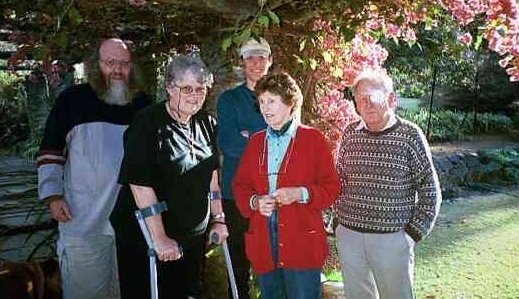
Steve, Val and Jethro Hayes with Phoebe & Peter Brown, Aug 2001
After Peter Brown was banned, those from Pietermaritzburg who attended rural branch meetings on Saturday afternoons would usually call on the Browns on the Saturday evening or the Sunday to let Peter know what had happened, as a kind of debriefing. He would often ask questions that we were unable to answer, about the people who were at the meeting, and what had happened to them. He would ask whether such and such a person was there, and then would tell us something about the person and their family.
Some 10-15 years later, when I was involved in rural ministry in the Anglican Church in Zululand, I was struck by the similarity between rural church congregations and the rural branches of the Liberal Party. And then in retrospect Peter Brown seemed like a kind of secular pastor or a bishop. He knew his sheep, he shepherded his flock and they heard his voice — not in a paternalistic way, but rather in a caring way. He knew the people and cared for them, and they knew him and cared for him. And indeed, the Zulu name for the Liberal Party — IBandla leNkululeko — could be translated back into English as "Church of Redemption".
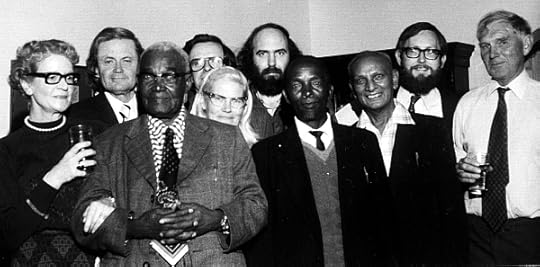
Some Natal Liberals who had been banned: Heather Morkill, Ken Hill, Selby Msimang, Cosmas Desmond, Jean Hill, Stephen Hayes, Enock Mnguni, E.V. Mohamed, John Aitchison, Peter Brown. 1976
When Elliot Mngadi and Peter Brown were banned in 1964, others stepped in to take their place. Mike Ndlovu took over from Elliot Mngadi as northern Natal regional organiser, until he too was banned. John Aitchison and Chris Shabalala took over some of the work done by Peter Brown in the Midlands, and they were both banned in 1965. I tried to visit some of the branches after they were banned, though also preparing for my final exams at university, then went home to Johannesburg for the vac. My banning order was signed on 11 January 1966, but I left the country to study in the UK after an all-night drive to the border on 18 January, before it could be delivered.
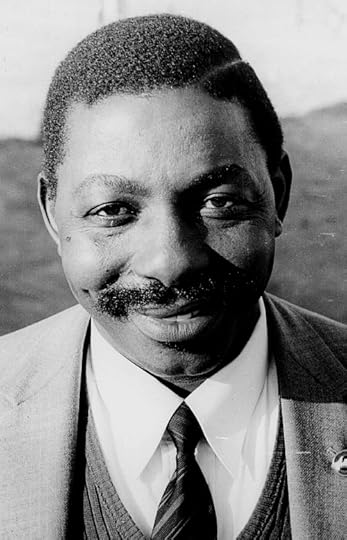
Elliot Mngadi
When Elliot Mngadi was banned, Peter Brown helped him to set up a business of a fish and chip shop at his home at Roosboom, near Ladysmith, which was under threat of ethnic cleansing. He had given up his job as a court interpreter to become a fulltime-organiser for the Liberal Party and the Northern Natal African Landowners Association. When he was banned he could not enter any court except as a complainant, defendant, witness or accused, so he could not go back to his old job.
The Liberal Party was not the first non-racial political party in South Africa; that honour belongs to the Communist Party. But the Communist Party was not always non-racial, and at one time was associated with the slogan "workers of the world unite and fight for a white South Africa". It was when the party line from Moscow changed that the Communist Party became non-racial. And perhaps the fact that the Communist Party was the first to become non-racial was what led the Nationalist government to identify non-racialism with communism, and to regard liberalism and communism as the same thing.
After the Communist Party was banned in 1950 white communists and leftists formed the Congress of Democrats, and formed part of the Congress Alliance. And though the ANC was willing to cooperate with the Liberals, and quite a number of Liberals, like Selby Msimang, were dual members of both the Liberal Party and the ANC, the Congress of Democrats wanted nothing to do with the Liberal Party, and their hostility persists to this day. Only last August Rica Hodgson (formerly of the COD) repeated in a radio interview the tired old communist canard that the Liberal Party did not allow blacks to join.
So Michael Cardo's biography of Peter Brown does a great deal to set the record straight, and he covers the relations between the Liberals and the Congress of Democrats fairly well. It's just a pity that it wasn't about 10-15 pages longer, giving more detail about the Liberal Party in Natal between about 1962 and 1965. If that would have made the book too long, then something could have been cut from the story of Church Agricultural Projects, which, though it deserves to be recorded in its own right, was less central to Peter Brown's concerns.








January 9, 2011
Muslims, Christians and religious violence
One of the most interesting news stories last weekend was the one about Muslims turning out to Christian services in Egypt to act as human shields after the bombing of a church the previous weekend. In Egypt, ministers and movie stars turn out for trouble-free Christmas mass – Ahram Online: "Amidst high-security and in an unprecedented show of solidarity, Muslims and Copts gathered at churches across Egypt Thursday night to observe the Coptic Christian Christmas eve mass".
And it appears that it wasn't just ministers and movie stars, but a lot of ordinary Muslims attended the Coptic Christmas services (the Coptic Church follows the old calendar). This interview with the Egyptian Ambassador in Germany is particularly interesting: tehran times : Muslims are standing side by side with the Copts: Egyptian ambassador:
Q: Mr Ambassador, after the New Year's Day attack on a Coptic Christian Church in Egypt that killed 21 people, Copts in Germany fear assaults by extremists, and police are guarding Coptic churches. Are you planning to visit a Coptic community to show your solidarity?
A: Of course I will join the Christmas church service in the Egyptian Coptic church in Berlin — as I do every year. I will express my heartfelt condolence to our citizens in my function as their ambassador. Egyptians are Muslims, Copts as well as Jews — the country has always been multireligious. While the overwhelming victims of the terrorist act were Coptic Christians, it was clearly directed against Egypt as a whole.
Q: Dutch Muslim organizations offered to guard Coptic churches. Is that reasonable?
A: Of course it is. Similar things are also happening in Egypt: Muslims are standing side by side with the Copts. We are all one people.
Interreligious violence is nothing new. Though Samuel Huntington predicted an increase of such things in the post-Cold War world in his book  The Clash of Civilizations and the Remaking of World Order, they were not uncommon even during the Cold War, though they were not perhaps as widespread or as frequent. India, especially in the period preceding partition in 1947, Northern Ireland and Lebanon were notorious for such clashes in the Cold War period. But such clashes seem to have become more widespread and more frequent in the post-Cold War period, as Huntington predicted.
The Clash of Civilizations and the Remaking of World Order, they were not uncommon even during the Cold War, though they were not perhaps as widespread or as frequent. India, especially in the period preceding partition in 1947, Northern Ireland and Lebanon were notorious for such clashes in the Cold War period. But such clashes seem to have become more widespread and more frequent in the post-Cold War period, as Huntington predicted.
Perhaps what we are now seeing in Egypt is a sign of a growing public revulsion against such things, with more people being prepared to take a stand against them. The idea of "human shields" is not new, and it is not likely to be immediately effective. Many people from various parts of the world went to Iraq to be human shields to deter the American bombing of that country, but they failed to prevent it. Islamist terrorists are unlikely to be deterred by the presence of Muslims in a Christian church. Most of the victims of Islamist terrorists are Muslims anyway, and in Iraq as many mosques have been bombed as Christian churches in the last 8 years or so.
What might be effective, though it might take many martyrs before the message sinks in, is the fact that many people are prepared to make a public stand, and to demonstrate their revulsion against violence by being willing to place themselves in danger. It remains to be seen whether this is just a flash in the pan, or the beginning of a real popular movement.








January 4, 2011
Tolstoy Remains Snubbed in Russia – NYTimes.com
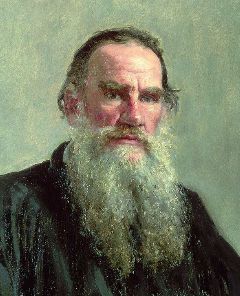
Leo Tolstoy (1828-1910): excommunicated by the Russian Orthodox Church
A couple of months ago one of Russia's elder statesmen set out on a paradoxical mission: to rehabilitate one of the most beloved figures in Russian history, Tolstoy.
This would have seemed unnecessary in 2010, a century after the author's death. But last year Russians wrestled over Tolstoy much as they did when he was alive. Intellectuals accused the Russian Orthodox Church of blacklisting a national hero. The church accused Tolstoy of helping speed the rise of the Bolsheviks. The melodrama of his last days, when he fled his family estate to take up the life of an ascetic, was revived in all its pulpy detail, like some kind of early-stage reality television.
via Tolstoy Remains Snubbed in Russia – NYTimes.com. By ELLEN BARRY and SOPHIA KISHKOVSKY. Published: January 3, 2011. Hat-tip to Ad Orientem: Russia still wrestling with Tolstoy.
This article provides yet more evidence, if any were needed, that the media don't "get" religion.
"I understood that there would not likely be a decision to return him to the church," said Mr. Stepashin, now president of the Russian Book Union. "But as for the attitude to him as a person, as a person who did a lot for Russian culture and for the Russian language, I just counted on that, on a change of attitude toward him."
The church's letter of response, published in a state-run newspaper, Rossiyskaya Gazeta, suggested not. It acknowledged Tolstoy's "unforgettable, beautiful works," and said Russian Orthodox readers were allowed to say solitary prayers for him on the anniversary of his death.
But its tone was mournful, calling Tolstoy the most "tragic personality" in the history of Russian literature. It said that Tolstoy "purposely used his great talent to destroy Russia's traditional spiritual and social order" and that it was "no accident that the leader of the Bolsheviks extremely valued the aim of Leo Tolstoy's activity." So there could be no candles burned for Tolstoy inside Orthodox churches and no commemorations read, according to the letter, signed by the cultural council secretary to Patriarch Kirill I, the church's leader.
Mr. Stepashin said he expected this response and was glad the letter included some praise.
But intellectuals did not hide their astonishment.
I'm not quite sure what he was expecting. It would be dishonest of the Russian Orthodox Church to pretend that Tolstoy was Orthodox when he wasn't. They acknowledge that he was a great writer, but he was not Orthodox. Tolstoy explicitly rejected Orthodox Christianity.
But here, perhaps is the nub othe matter:
"Any power tries to adapt great people to its needs," he added. "The current authorities don't adapt him, or they are not clever enough. Maybe they are so self-confident they don't think they need to."
Thank God the Russian Church doesn't seem to feel the need to play these sordid little power games that the media and "intellectuals" seem to expect of it.








January 3, 2011
2010 in review
The stats helper monkeys at WordPress.com mulled over how this blog did in 2010, and here's a high level summary of its overall blog health:

The Blog-Health-o-Meter™ reads Wow.
Crunchy numbers
Madison Square Garden can seat 20,000 people for a concert. This blog was viewed about 66,000 times in 2010. If it were a concert at Madison Square Garden, it would have performed about 3 times.
In 2010, there were 166 new posts, growing the total archive of this blog to 794 posts. There were 135 pictures uploaded, taking up a total of 14mb. That's about 3 pictures per week.
The busiest day of the year was October 25th with 375 views. The most popular post that day was Underrepresented at Cape Town 2010.
Where did they come from?
The top referring sites in 2010 were stumbleupon.com, methodius.blogspot.com, avowofconversation.wordpress.com, Google Reader, and reddit.com.
Some visitors came searching, mostly for jesus christ, google installer, jesus, google installer is trying to access the internet, and what is google installer.
Attractions in 2010
These are the posts and pages that got the most views in 2010.
1
Underrepresented at Cape Town 2010 October 2010
9 comments
2
The appearance of Jesus Christ: redux April 2010
2 comments
3
What is Google installer, and why is it trying to access the Internet? November 2009
12 comments
4
Stuff to do on Sunday if you're bored September 2007
7 comments
5
About me April 2007
18 comments








January 2, 2011
The totally depraved US judicial system: book review
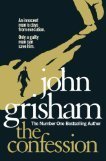 The Confession by John Grisham
The Confession by John Grisham
My rating: 4 of 5 stars
Like many of John Grisham's books, this one is a legal one — a young man has been convicted of the death of a schoolfellow, and sentenced to death, though on flimsy evidence and an extorted confession. A few days before his scheduled execution in Texas a man confesses to a church minister in Kansas, several hundred miles away, that he was the real murderer, but vascillates about whether to make his confession public or not.
This scenario makes for a dramatic story, as the condemned, but possibly innocent man and his lawyers exhaust all the avenues of appeal, and the man who claims to have done it tries to make up his mind, while the church minister has to decide whether to believe him or not, and what to do about if he does.
While it isn't a great work of literature, it is one of Grisham's best, in the genre he has made his name in, and it's a good read. It also, like many of Grisham's novels, raises moral and ethical questions about the system of criminal justice. And it's just here that I have some questions about it, and find the story improbable.
Admittedly I am not a fundi on the American criminal justice system, its strengths and weaknesses. I know it mainly from reading novels like Grisham's, and films based on such novels. In both this one, and in another one that I read recently, The appeal, Grisham clearly believes that the system of elected judicial officials that prevails in some American states can, and frequently does, lead to miscarriages of justice. And while in novels like this he piles it on a bit thick for dramatic effect, he was himself a practising lawyer before he took up novel-writing, so he does know what he's talking about. And it's not just John Grisham who writes stuff like this. To kill a mockingbird by Harper Lee has a similar theme, as did the film based on it, which I saw more than 40 years ago, and a similar theme is found in several other novels and films.
Twenty-five years ago there was a popular TV series, The A-team, that was based on a similar premiss: the A-team would be confronted with corrupt officials in the American judicial system, usually a sheriff and/or judge in a small town who abused their authority, and would correct injustices using spectacular extra-judicial methods. And that was nothing new – the legends of Robin Hood and the corrupt Sheriff of Nottingham go back to the 13th or 14th century.
Bent cops are nothing new. We have them here in South Africa. There are traffic cops who threaten to give tickets for bogus offences, but offer not to if they are offered a "cold drink". Stories of the Rivonia Trial, of Nelson Mandela and his associates, reflect pretty badly on the prosecutor, Percy Yutar, but though they could have been sentenced to death under the laws of the time, they were not. Perhaps that illustrates Grisham's thesis, since judges in South Africa were not, and are not, elected.
The problem with this book, however, is that Grisham manages to create the impression that the entire American judicial system, and especially that part of it based on elected officials, is corrupt from top to bottom. Of course it adds to the drama of the story, when everything that can possibly go wrong does go wrong, when corruption permeates every level of the judicial process. Grisham approaches it like a good Calvinist: he portrays it strongly as total depravity. But if it really is as bad as Grisham makes out, then the "free" world is in a lot more trouble than we thought it was.








December 30, 2010
Souvenirs of the decade
And so we come to the last day of the year, the last day of the first decade of the 21st century, of the third millennium. So 10% of the 21st century, 1% of the third millennium, has passed.
I am reminded of a poem by Leopold Senghor
I dream in the intimate semidarkness of an afternoon
I am visited by the fatigues of the day
The deceased of the year, the souvenirs of the decade
Like the procession of the dead in the village on the horizon of the shallow sea
It is the same sun bedewed with illusions
The same sky unnerved by hidden presences
The same sky feared by those who have a reckoning with the dead
And suddenly my dead draw near to me…
And so here are some of my dead, my deceased of the year, of the decade. Some I knew well, and some I knew less well. Some were close friends, others acquaintances. Some I had seen recently, others I had not seen for several years. But all are people I have met and spoken to and remember.
Wetherell, Philip. (1945-2010). England, Namibia
Smith, Nico. (1929-2010). South Africa
Harper, Michael. (1931-2010). England
Leonard, Graham Douglas. (1921-2010). UK, South Africa
Sibiya, Blackie. (1940-2009). South Africa
Lamprecht, John David Blatt. (Don). (1940-2009). South Africa
Benedikz, Benedikt. (1932-2009). England, Ireland, Iceland
Fenton, John. (The Prin). (1921-2008). England
Wood, Richard. (1920-2008). England, Namibia, South Africa
Sambu, Melumzi. (1950-2008). South Africa
Pribojan, Nikolas Richard. (Fr Nazarius). (1951-2008). South Africa, USA, Yugoslavia, Canada, Wales
Pierce, Daisy. (-2007). USA, Namibia
Thamaga, Louisa. (-2007). South Africa
Mabula, Simon Martin. (1939-2007). South Africa
Beukes, Johann. (-2007). South Africa
Hirst, Arnold. (1936-2007). England, South Africa
Conway, Mary Jane. (Jane). (1928-2006). England
Glass, Edward Eric Ivor. (Ivor). (1925-2005). South Africa
Stubbs, Aelred. (1923-2004). South Africa, England
Kellis, Nectarios. (George). (1953-2004). Madagascar, Australia, Greece
Papapetrou, Petros. (1949-2004). Egypt, Cameroun, South Africa, Cyprus
Naudé, Beyers. (1915-2004). South Africa
Thamaga, Simon August. (1946-2004). South Africa
Brown, Peter. (1924-2004). South Africa
Cox, Alan. (1944-2004). Pakistan, England
Hurley, Denis Eugene. (1915-2004). South Africa
Wadsworth, Kate. (c1945-2003). South Africa
Morrow, Edward Sydney. (Ed). (1934-2003). England, Zimbabwe, Namibia, South Africa
Kotze, Theo. (-2003). South Africa
Hesse, Mike. (-2003). UK, South Africa
van Beijma, Jan Michiel. (-2002). South Africa
Hill, Ken. (-2002). South Africa
Galletis, Anna. (c1939-2002). South Africa
Briggs, Margaret. (1941-2002). South Africa
Briggs, Robin Campbell Rawdon. (1940-2002). South Africa
Kraft, Richard. (Rich). (1936-2001). South Africa, USA
The list is by no means complete. Some, like Kate Wadsworth (born O'Meara), a fellow student, I had not seen since leaving the University of Natal in 1965. Two were murdered (Alan Cox and Jan van Beijma). Two died in an aircraft crash (Petros Papapetrou, Pope and Patriarch of Alexandria, and Bishop Nectarios Kellis of Madagascar).
Statistically, I'm not likely to see the end of the next decade, and so I probably won't be compiling a similar list at the end of 2020. Perhaps I'll be on someone else's list. I have thought that it would be rather nice to survive until Pascha 2031, and pop my clogs in Bright Week of that year. That's because I was born on Western Easter in 1941, and my 11th birthday fell on Western Easter, but the next time my birthday will fall on Western Easter will be 2031, which will also be Orthodox Pascha. But it's statistically unlikely that I'll last till then.
The decade seems to have been a fairly disastrous one.
It began with George Bush II becoming US president, and attacks on the World Trade Center and Pentagon.
In 2002 was the US invasion of Afghanistan and in 2003 the US invasion of Iraq, and in 2004 the tsunami that killed about 200000 people.
The decade ended on a more pleasant note when we hosted the football World Cup, and though our team didn't make it to the quarter-finals, we did manage to beat France (the 1998 winners) and move up a few places in the world rankings. As one of my blogging friends puts it Tinyiko Sam Maluleke's Blog – Thinking Allowed!: Twendy Ten:The Year That Was!:
South Africa became a place where the world can score goals. For a people long at war with one another, a people notoriously mistrusted, a people plagued by a debilitating sense of self-doubt; the FIFA world cup was good. Yes it was good even though FIFA made the money. It was good even though we built magnificent stadia instead of toilets and houses for a people who have dire need of these. These problems remain. 'Twendy ten' did not and could not solve them. Where in the world has the FIFA World Cup eradicated poverty and spearheaded general community development? Yet in and through 'twendy ten' we dissapointed the doubting thomases inside (ourselves) and outside. We had no right to lay out such a successful world cup! This is Africa, remember? The lost continent? It was not just Danny Jordan. It was not just Irvin Khoza. It was us. All of us. We embraced the world. And we did it not because of, but in spite of Sepp Blatter!
Back to more personal stuff…

Our Toyota Venture, when we first got it at the end of 2000
At the end of 2000 we bought a Toyota Venture, second-hand, but in good condition (only 27000 km on the clock), and over the next 5 years we used it to take people from our mission congregations to church services in real churches (as opposed to classrooms) and to other church gatherings and conferences. In 2006 it was stolen, which put an end to that.
With the insurance money we were able to replace it with a Subaru Legacy, which being a station wagon, could fit a few kids in the back, but it is not a people carrier, like the Venture.
2006 was also the year of three dead dogs. Early in the year our bonsai Alsatian, Alexa, died. She started coughing at about 3 am, and within a couple of hours she was dead. We got a puppy, Ralf, to replace her, and within 12 days he was dead too. We managed to get him to the vet, but he died on the examining table, of bilary, which had probably killed Alexa as well. We then got another puppy, Mardigan. He was poisoned by the thieves who stole the Venture, and died after three days and R2000 in vet's bills. A couple of months later we got another puppy, Samwise, and he is still with us.

Alexa, February 2001
We had also got Alexa in 2001. Our older dogs, Lucy and Gilgamesh, died within a few weeks of each other, and the younger one, Ariel, went into mourning. She went off her food, and looked miserable and dejected, so we got Alexa to be a companion.
At the beginning of the decade, 1 January 2001, we planted two floss-silk trees, to mark the new millennium. We called them Laurelin and Telperion. In the first couple of years they nearly died – each winter they were hammered by the frost, and only a stump was left. Then in spring a little green shoot would appear, and they would revive. Eventually Laurelin survived a winter with trunk intact, but after a few years Telperion did not grow back, and we got a replacement.

Laurelin, after planting on 1 January 2001
Ten years later…
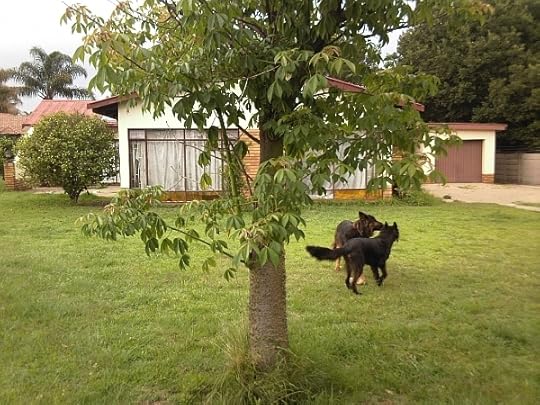
Laurelin, 31 Dec 2010
Happy New Year!








Theodicy of naturalists
In a recent blog post (Nouslife: Theodicy of the naturalists) Andii Bowsher raised a point that has puzzled me for some time: Loyal Rue, an evolutionary naturalist, says that scientists should not be too hasty in letting the rest of us in on the secret that religions are adaptive illusions that have enabled the human race to evolve and survive, because if we came to realise that we might abandon the illusions and thus lose their adaptive advantage. "If we expose our religions as the lies they really are, humanity might go extinct."
And Andii's puzzlement, like mine, is why, on a naturalistic account, we should care whether the human race goes extinct or not?
Kevin Parry, in a post on his blog a couple of years ago raises the same question in a slightly different way. In discussing Ursula le Guin's novel, The dispossessed
he writes Memoirs of an ex-Christian: Survival of the fittest (or most ethical)?:
Not only is such an argument an example of the naturalistic fallacy, but as the quote above clearly shows, the fittest are not necessarily those who are the most violent or domineering. As far as I understand, those organisms that are the strongest (or fittest), in the context of evolutionary theory, are those who are the most successful in passing along their genes to the next generation. And what better environment to successfully bear children than in a stable, peaceful society based on a common code of ethics.
And it seems to me that that is an example of the very naturalistic fallacy he refers to. The assumption seems to be that extinction is bad, non-extinction (ie survival) is good — but why?
For those unfamiliar with these terms (like "naturalistic fallacy), the following article and definitions may help: Naturalistic Fallacy:
Naturalism (as ideology) is a direct effect or benefactor of the naturalistic fallacy – naturalism being the idea that all explanations and descriptions of the universe and humankind must be based on a 'natural' understanding of our-selves and universe, given that human beings are a part of nature.
The "naturalistic fallacy" is the belief that we can derive an idea of how things ought to be from the way they are. The problem with it is the gap between the "is" and the "ought".
The reason I found Andii Bowsher's question interesting is that I have found the same problem. It is a problem that those who claim to have a naturalistic worldview seem to have most difficulty in understanding. If you ask them about it, they insist on answering a quite different question, and tend to say that naturalists/atheists (they are usually atheists) can be just as moral as religious believers, and believers don't have a monopoly on morality etc. The question they always evade is why one should be moral, or think that anything has value. It seems to be the anthropomorphization of evolution, which makes it anything but "scientific".
I tried, as an experiment, copying Andii's post to a number of atheist and religious newsgroups, in which I could hope to find a few, at least, who might claim a naturalistic worldview. After a week, however, I had failed to find anyone who could explain it, and those who did respond tended to evade the question, or to misinterpret it, or both.
They also usually fail to understand the basis of Christian morals/ethics/values. Perhaps that it not quite so surprising, as many Christians also fail to understand it, and thus give a distorted picture to those who are not Christians. This view (or rather caricature) is that Christians believe we cannot be moral without God as an authority-figure to keep us in line with the threat of hell if we misbehave. The real basis of Christian morals/ethics/values is rather teleological: that God has made the world with a purpose, and that that purpose is part of its nature, and that some behaviour is consonant with that purpose and nature while other behaviour is not, and is therefore destructive.
But the one thing the naturalistic worldview denies is teleology or purpose. The universe came into existence or has always existed as a cosmic accident, and there is no meaning or purpose to existence. In such a view it is not meaningful to say that survival is "better" than extinction, or that existence is "better" than non-existence. While I have no doubt that some people who hold a naturalistic worldview are moral and have values of one sort to another, what I find difficult to understand is how they get from the "is" to the "ought" within the naturalistic worldview. I'm still looking for someone to explain that.








December 28, 2010
Recent reading: The Road, by Cormac McCarthy
My rating: 4 of 5 stars
Christmas for me has been a season for reading, as most members of the family give me books as Christmas presents, and so much of my blogging in this season is about books I've been reading. This Christmas Val and I gave each other similar books, those dystopian "end of civilisation" books, describing the life of survivors after some disaster has wiped out most of the human race. It's a genre on its own, and two of my favourites in the genre are A canticle for Leibowitz by Walter M. Miller and Earth abides by George Stewart.
Unlike those two, which describe some form of community, The road describes the journey of a father and son, whose main object is to avoid most of the humans they meet. One is not told their names or ages, though the boy appears to be about 6-8 years old, and there are hints that he was born after the disaster, and so had known no other life. Their location isn't described either, though it is somewhere in the northern hemisphere, since they are travelling southwards in the hope of finding somewhere warmer to survive the winter, a global nuclear winter, with polluted air and water. There are no birds, no farm animals, and they live as scavengers, looking for unlooted stores of food and clothing, and trying to hide from other human beings they encounter, most of whom have turned to slavery and cannibalism.
So the book is basically about the journey, a journey without a destination, just the hope of finding somewhere warmer, where survival may be a little easier, and perhaps an even fainter hope of finding a human community. The father tells the son that there are "good guys" somewhere, whom they hope to find, but none of the few people they meet appear to fall into that category, in most cases they don't even try to find out, avoiding human contact as far as possible, because they think that all are "bad guys", which they usually turn out to be. The people and places have no names, because names are a sign of human community, and there is no human community left, other than war bands of raiders in the new Dark Ages.
So though it is a post-cataclysm book, it reminded me of another book I read many years ago, Sammy going south by W.H. Canaway. It is about an English boy, Sammy Hartland, who lives with his parents in Egypt, and is orphaned when his parents are killed in a bombing raid. When they were alive they had talked of sending him to his aunt Jane in Durban until the crisis was over, and so he sets out on his own, knowing that Durban is somewhere in the south. The similarity is simply in the need to travel south. Sammy Hartland encounters a lot of human beings, some of whom help him, and others who seek to exploit him for their own financial or emotional gain. And so The road is simply about the journey, with the travellers having to rely on their own resources, and what they can scavenge on the way. Whatever disaster caused their present plight is irrelevant. The past is irrelevant, the future vague and uncertain. Both are erased by the need to survive for just one more day, and the need for survival erases human compassion. The father becomes one of the "bad guys" he fears, treating others as he fears they will treat him. And the son alone retains a vestige of human compassion.








December 23, 2010
Voyage of the Dawn Treader: film (and book) review
 The Voyage of the Dawn Treader by C.S. Lewis
The Voyage of the Dawn Treader by C.S. Lewis
My rating: 5 of 5 stars
I went to see the film of The voyage of the Dawn Treader last night, and today finished reading the book for the fifth time, and noted some of the differences between the film and the book.
I hadn't seen the previous two Narnia films in the current series, perhaps for the same reason as I never saw (and don't want to see) the films of Lord of the Rings, because I don't want the film to interfere with the pictures in my head when I read the books. But The voyage of the Dawn Treader is different. It isn't set in Narnia itself, and is more like a series of short stories.
In the prepublicity leading up the the film release there was some talk of the film removing all the "Christian" elements of the book, and interviews with the producers in various publications, in which they said that they weren't Christian, and so hadn't handled it as a Christian story (see, eg New "Narnia" Film Stirs Religious Controversy – ABC News).
Well, I don't think C.S. Lewis himself regarded it as a specifically Christian story, though it is, of course, informed by his Christian worldview. The most overtly Christian thing about it is at the end, where Aslan says that he is known in our world by another name, and the children returning to our world need to learn to know him by that name, and that was retained in the film. What disappeared in the film was a lot of the theological nuances, and as it was written as a children's story, they wouldn't be apparent to most children on a first reading either. Perhaps seeing the film might encourage childrent to read the book.
One of the things that stood out for me was that Reepicheep came across as a much more sympathetic character in the film than in the book. The first couple of times I read it I found him rather tiresome, and sympathised with Caspian, when Reepicheep said to him, 'Your Majesty promised to be a good lord to the Talking Beasts of Narnia.'
'Talking beasts, yes,' said Caspian. 'I said nothing about beasts that never stop talking.'
And perhaps something of the film lingered when I reread the book, because I saw Reepicheep in a new light.
The film handled Eustace Scrubb fairly well, and showed his change from an unpleasant character to a somewhat improved character fairly well, though some of this was lost because in the film most of the changes took place in his dragon form, and not his boy form. Edmund and Lucy, however, appeared much older in the film than they do in the book. Perhaps it was difficult to handle their appearing to be older while in Narnia and reverting to the chronology of this world on their return.
One of the things I found interesting was the things that the film added to the book, and those that it removed, or emphasised less.
One of the first additions was people from the Lone Islands disappearing into the mist, and a girl from the Lone Islands stowing away on the Dawn Treader and becoming a kind of companion to Lucy, though her role is not clear, and it is not helped by her somewhat wooden-faced performance.
What gets lost in that part of the story, partly because of the changes and spurious additions, is the point that comes out strongly in Lewis's narrative — that bureaucrats who pay more attention to statistics and economic trends than to people tend to lose sight of justice, and are unworthy of their office. I can't help wondering if this was perhaps a bow to political correctness on the part of the film's producers, in a time when governments keep telling us that cuts in spending have to be made because of the statistics, regardless of the effect that they might have on people.
The order of events is also changed somewhat. In one sense this does not matter very much, since each episode on the voyage, each island or archipelago visited is independent of the others. But in the book there is a progression. At the first stop, at the Lone Islands, the voyagers are faced by mainly human evil – slave traders and a corrupt bureaucracy.
In the book the next stop is at the dragon island, where Eustace is briefly transformed into a dragon, and there, of course, magic enters the picture, certainly in the actual transformation. But it is also human evil, in that it is linked to Eustace's dragonish thoughts. The actual transformation is handled quite well in the film. Where it is different, and not improved, is that while in the book Eustace is transformed back into a boy before they leave the island, in the film it is moved much later, and Eustace stays in dragon form for longer, I suspect because the film producers wanted him to fight the sea-serpent in his dragon form rather than his human form.
The sea-serpent episode is also moved closer to the end of the film, and that, to me, is one of its greatest weaknesses. It tends to turn the film into a B-movie like Anaconda, and I got the impression that the producers simply could not resist the temptation to play with Anaconda-like special effects in 3D, with close-ups of the lunging head that kept snapping but never seemed to actually do any significant damage. In the book it is the boy Eustace, rather than the dragon, who attacks the sea-serpent, his first significant (though ineffectual) act of bravery in the story.
The other significant addition in the film is the quest to collect the swords of the seven missing lords, and to bring them together on Aslan's table, and the change in Eustace is marked by him being the one to put the last sword there, which is supposed to make everything right.
What is missing from the film is Ramandu.
Ramandu's daughter makes an appearance, and she is a star, and goes back to being one, instead of marrying Caspian (though the film does show the attraction he feels towards her). But Ramandu, though mentioned, does not appear at all, and this is where some of the theological nuances get lost in the film.
'In our world,' said Eustace, 'a star is a huge ball of flaming gas.'
'Even in your world, my son, that is not what a star is, but only what it is made of. And in this world you have already met a star; for I think you have been with Koriakin.'
'Is he a retired star, too?' said Lucy.
'Well, not quite the same,' said Ramandu. 'It was not quite as a rest that he was set to govern the Duffers. You might call it a punishment. He might have shone for thousands of years more in the southern winter sky if all had gone well.'
'What did he do, Sir?' asked Caspian.
'My son,' said Ramandu, 'it is not for you, a son of Adam, to know what faults a star can commit.'
And so Lewis hints, briefly, at the possibility of the repentance of fallen angels. And while the Bible, and other books, like the Book of Enoch, speaks of the sons of gods marrying the daughters of men, Lewis has a son of Adam marrying a daughter of the gods. But the film skips this episode.
I suppose one of my disappointments, with both the film and the books, is the sea-serpant episode. In the film the sea-serpent is reduced to a lunging, snapping, special-effects reptile, with no real significance for the story. But in the book, while the sea-serpent could have had some Rahab-like characteristics (cf Isaiah 55:9-11), Lewis makes it merely dim-witted.









